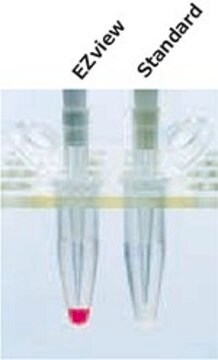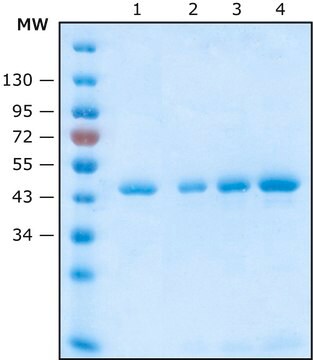Kluczowe dokumenty
11815016001
Roche
Macierz powinowactwa anty-HA
from rat IgG1
Synonim(y):
matryca powinowactwa, anty-ha
About This Item
Polecane produkty
pochodzenie biologiczne
rat
Poziom jakości
białko sprzężone
agarose conjugate
forma przeciwciała
purified immunoglobulin
rodzaj przeciwciała
primary antibodies
klon
3F10, monoclonal
Formularz
slurry
opakowanie
pkg of 1 mL (settled resin volume)
producent / nazwa handlowa
Roche
izotyp
IgG1
sekwencja epitopowa
YPYDVPDYA
pojemność
2-8 nmol/mL binding capacity
temp. przechowywania
2-8°C
Powiązane kategorie
Opis ogólny
Specyficzność
Immunogen
Zastosowanie
- Western blotting using the Anti-HA antibody
- Silver staining (or similar protein stain)
- In coimmunoprecipitation.
- Immunoprecipitation of HA-tagged proteins from mammalian, bacterial, and yeast cell extracts
- Affinity column purification of HA-tagged proteins from crude protein extracts
Cechy i korzyści
- Achieve enhanced specificity and reduced cross-reactivity of Anti-HA High Affinity.
- Use nondenaturing conditions for elution of your HA-tagged protein of choice.
- Purify even rarely expressed HA-tagged proteins.
- Highly specific to YPYDVPDYA.
- Suitable for purification of proteins containing HA-epitop as N-terminal, C-terminal or internal fusion.
- Applicable with crued cell extracts from mammalian, bacterial and yeast expression systems.
Jakość
Postać fizyczna
Komentarz do analizy
Inne uwagi
Nie możesz znaleźć właściwego produktu?
Wypróbuj nasz Narzędzie selektora produktów.
Kod klasy składowania
12 - Non Combustible Liquids
Klasa zagrożenia wodnego (WGK)
WGK 1
Temperatura zapłonu (°F)
does not flash
Temperatura zapłonu (°C)
does not flash
Wybierz jedną z najnowszych wersji:
Masz już ten produkt?
Dokumenty związane z niedawno zakupionymi produktami zostały zamieszczone w Bibliotece dokumentów.
Klienci oglądali również te produkty
Protokoły
Anti-HA Affinity Matrix Protocol & Troubleshooting
Nasz zespół naukowców ma doświadczenie we wszystkich obszarach badań, w tym w naukach przyrodniczych, materiałoznawstwie, syntezie chemicznej, chromatografii, analityce i wielu innych dziedzinach.
Skontaktuj się z zespołem ds. pomocy technicznej











